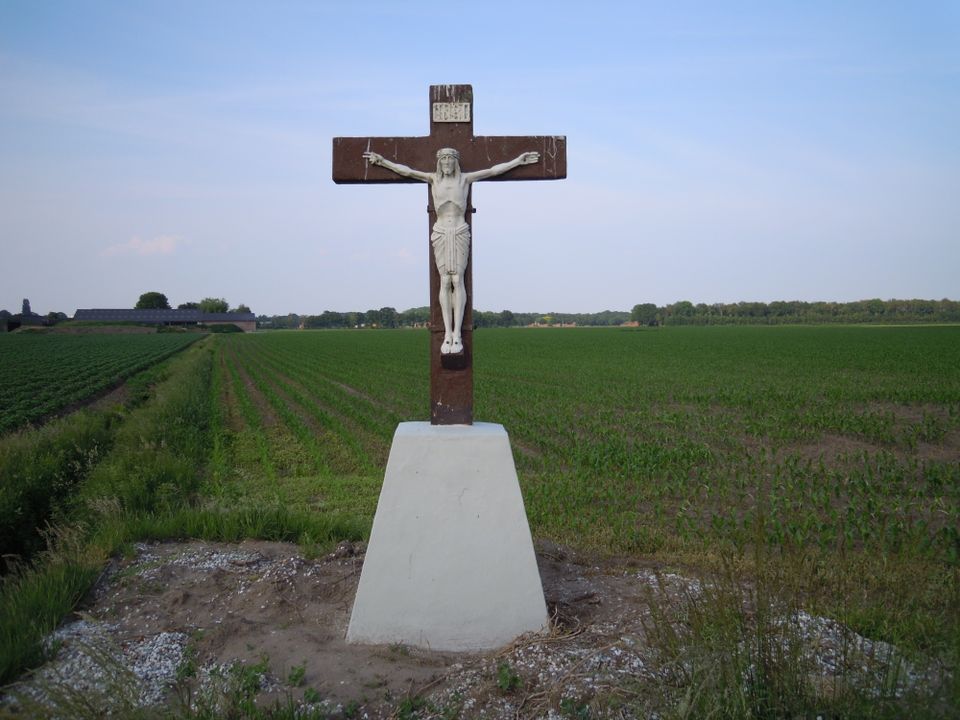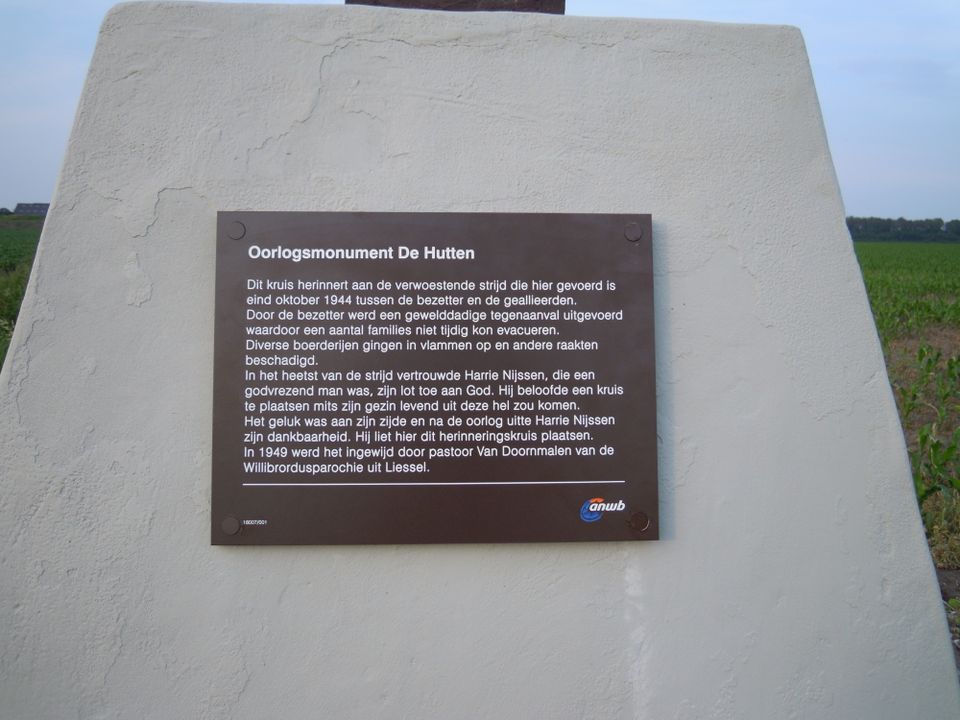The cross in 'Niemandsland' (No Man's Land)
Contact
Pijlstaartweg 13
5721 SK Asten Plan your route to The cross in 'Niemandsland' (No Man's Land)
Shape and material
A corpus has been attached to the cross in 'Niemandsland' (No Man's Land) in Asten. The memorial cross is positioned on a concrete pedestal.
Change
The cross originally stood on a crossroads on the land of the Nijssen family. When the road needed to be extended slightly due to land consolidation work in the 1970s, the cross had to be relocated. The right arm of the cross was stolen in October 2017. It was found in a nearby cornfield and has since been replaced.
The history
The cross in 'Niemandsland' in Asten is a memorial to the devastating battle that raged here at the edge of the Staatbos (Dennendijkse Bos) in late October 1944 between the occupying forces and the Allies.
When leaving the bui…
Shape and material
A corpus has been attached to the cross in 'Niemandsland' (No Man's Land) in Asten. The memorial cross is positioned on a concrete pedestal.
Change
The cross originally stood on a crossroads on the land of the Nijssen family. When the road needed to be extended slightly due to land consolidation work in the 1970s, the cross had to be relocated. The right arm of the cross was stolen in October 2017. It was found in a nearby cornfield and has since been replaced.
The history
The cross in 'Niemandsland' in Asten is a memorial to the devastating battle that raged here at the edge of the Staatbos (Dennendijkse Bos) in late October 1944 between the occupying forces and the Allies.
When leaving the built-up area of Liessel, following Zandstraat and then crossing the E-3 at Zand and taking a short left on Pijlstaartweg, one passes several farms. During World War II, the families of Helmus Berkers, Cornelis Timmermans, Van de Wallen, Harrie Nijssen, Frans Hoeben and Toon Klaus lived here. This area was no man's land during the autumn of 1944. Following Asten's liberation by the Allies in September 1944, the occupiers retreated to behind the Peel canals. German patrols did continue to penetrate far into Asten on several occasions, however. During one of these reconnaissance missions, several Liessel inhabitants were killed when an abandoned ammunition box exploded. Liessel was also shelled on many occasions. This situation continued from 23 September until 27 October 1944.
The occupying forces launched a violent counterattack on 27 October 1944. Sadly, the Nijssen and Hoeben families had not been warned in advance, and were unable to evacuate in time. When the fighting broke out in full force near the farms, Hoeben and his family hid in their bomb shelter. Nijssen's basement offered little shelter, however, since its ceiling was made of wooden boards. From that Friday morning until the day before All Saints' Day, their house was hit by artillery several times. Family members watched from the window as the farms of both Frans Hoeben and Cornelis Timmermans were ablaze. They could hear their neighbour's cows lowing as they perished in the blaze. The deafening noise of striking projectiles, the rattle of machine guns and explosions that shook the entire house were petrifying. Nellie, the eldest daughter, was completely beside herself. Herman Engel, a person in hiding from Rotterdam, left behind from the labour camp, was even worse off. Distraught with fear, the family huddled together in the cellar. At about three o'clock, on what must have been the 31st of October, things were going from bad to worse. By nightfall, during a momentary lull, Harrie Nijssen gathered the courage to ask Frans Hoeben what their plans were. They said they wanted to stay in the shelter. "We have to get out of here," Harrie said, "because this shelter is not adequate."
Harrie Nijssen was a God-fearing man. In complete desperation, with no other solution available, he put his fate in God's hands. "Dear Lord," he prayed to himself, "if we come out of this hell here alive, I promise to erect a cross in Your name." He picked up a horse at Toon Klaus' house – their own horse was lying dead in the stable – harnessed it for the wagon and loaded it with a few household goods. Harrie and his family then rushed out of the line of fire, away from the fallen soldiers who were scattered around the edge of the forest and across the fields. German soldiers who had entrenched themselves in their house ordered the family to flee toward Meijel, as there were mines scattered everywhere. Along the way, the family was forced to take cover from duds several times. Finally, they reached Meijel unscathed. They did lose their eldest son, Jan, in the dark for a period of time. He was captured and interrogated by the occupying forces. Following this traumatic experience, the Nijssen family stayed with relatives in Meijel for several weeks. After the war, restarting the farm would not be lucrative.
Harrie Nijssen set sail for Canada with his family in 1949. The cross was placed exactly in the spot Harrie had pointed out. He had apparently deemed it unnecessary to inscribe the cross. After all, it was about a covenant between him and God alone.
Unveiling
The monument was consecrated in 1949 by Priest Van Doornmalen of the St. Willibrordus parish in Liessel.
Designer:
Type: cross
Location: The monument is situated on Pijlstaartweg (in the former hamlet of Hutten) in Asten.



